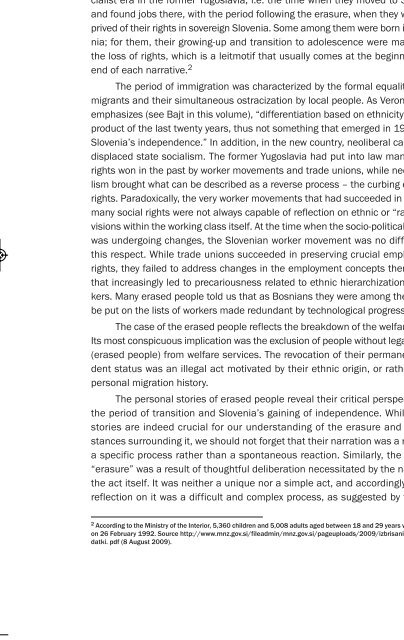The Scars of the Erasure_web
The Scars of the Erasure_web
The Scars of the Erasure_web
- No tags were found...
You also want an ePaper? Increase the reach of your titles
YUMPU automatically turns print PDFs into web optimized ePapers that Google loves.
<strong>Erasure</strong>_4a 10.1.11 20:29 Page 2020 THE SCARS OF THE ERASUREgleaned from <strong>the</strong>ir narratives and, indirectly, from <strong>the</strong> new definition <strong>of</strong> <strong>the</strong> bearer<strong>of</strong> sovereignty.<strong>The</strong>se changes in <strong>the</strong> system and <strong>the</strong>ir many aspects are <strong>the</strong> thread thatruns throughout this text. It is common for <strong>the</strong> erased people to compare <strong>the</strong> socialistera in <strong>the</strong> former Yugoslavia, i.e. <strong>the</strong> time when <strong>the</strong>y moved to Sloveniaand found jobs <strong>the</strong>re, with <strong>the</strong> period following <strong>the</strong> erasure, when <strong>the</strong>y were deprived<strong>of</strong> <strong>the</strong>ir rights in sovereign Slovenia. Some among <strong>the</strong>m were born in Slovenia;for <strong>the</strong>m, <strong>the</strong>ir growing-up and transition to adolescence were marked by<strong>the</strong> loss <strong>of</strong> rights, which is a leitmotif that usually comes at <strong>the</strong> beginning andend <strong>of</strong> each narrative. 2<strong>The</strong> period <strong>of</strong> immigration was characterized by <strong>the</strong> formal equality <strong>of</strong> immigrantsand <strong>the</strong>ir simultaneous ostracization by local people. As Veronika Bajtemphasizes (see Bajt in this volume), “differentiation based on ethnicity is not aproduct <strong>of</strong> <strong>the</strong> last twenty years, thus not something that emerged in 1991 withSlovenia’s independence.” In addition, in <strong>the</strong> new country, neoliberal capitalismdisplaced state socialism. <strong>The</strong> former Yugoslavia had put into law many socialrights won in <strong>the</strong> past by worker movements and trade unions, while neo-libera -lism brought what can be described as a reverse process – <strong>the</strong> curbing <strong>of</strong> <strong>the</strong>serights. Paradoxically, <strong>the</strong> very worker movements that had succeeded in winningmany social rights were not always capable <strong>of</strong> reflection on ethnic or “racial” divisionswithin <strong>the</strong> working class itself. At <strong>the</strong> time when <strong>the</strong> socio-political systemwas undergoing changes, <strong>the</strong> Slovenian worker movement was no different inthis respect. While trade unions succeeded in preserving crucial employmentrights, <strong>the</strong>y failed to address changes in <strong>the</strong> employment concepts <strong>the</strong>mselvesthat increasingly led to precariousness related to ethnic hierarchization <strong>of</strong> wor -kers. Many erased people told us that as Bosnians <strong>the</strong>y were among <strong>the</strong> first tobe put on <strong>the</strong> lists <strong>of</strong> workers made redundant by technological progress.<strong>The</strong> case <strong>of</strong> <strong>the</strong> erased people reflects <strong>the</strong> breakdown <strong>of</strong> <strong>the</strong> welfare state.Its most conspicuous implication was <strong>the</strong> exclusion <strong>of</strong> people without legal status(erased people) from welfare services. <strong>The</strong> revocation <strong>of</strong> <strong>the</strong>ir permanent residentstatus was an illegal act motivated by <strong>the</strong>ir ethnic origin, or ra<strong>the</strong>r, <strong>the</strong>irpersonal migration history.<strong>The</strong> personal stories <strong>of</strong> erased people reveal <strong>the</strong>ir critical perspective on<strong>the</strong> period <strong>of</strong> transition and Slovenia’s gaining <strong>of</strong> independence. While <strong>the</strong>sestories are indeed crucial for our understanding <strong>of</strong> <strong>the</strong> erasure and circumstancessurrounding it, we should not forget that <strong>the</strong>ir narration was a result <strong>of</strong>a specific process ra<strong>the</strong>r than a spontaneous reaction. Similarly, <strong>the</strong> naming“erasure” was a result <strong>of</strong> thoughtful deliberation necessitated by <strong>the</strong> nature <strong>of</strong><strong>the</strong> act itself. It was nei<strong>the</strong>r a unique nor a simple act, and accordingly, publicreflection on it was a difficult and complex process, as suggested by <strong>the</strong> fact2 According to <strong>the</strong> Ministry <strong>of</strong> <strong>the</strong> Interior, 5,360 children and 5,008 adults aged between 18 and 29 years were erasedon 26 February 1992. Source http://www.mnz.gov.si/fileadmin/mnz.gov.si/pageuploads/2009/izbrisani-koncni_podatki.pdf (8 August 2009).


